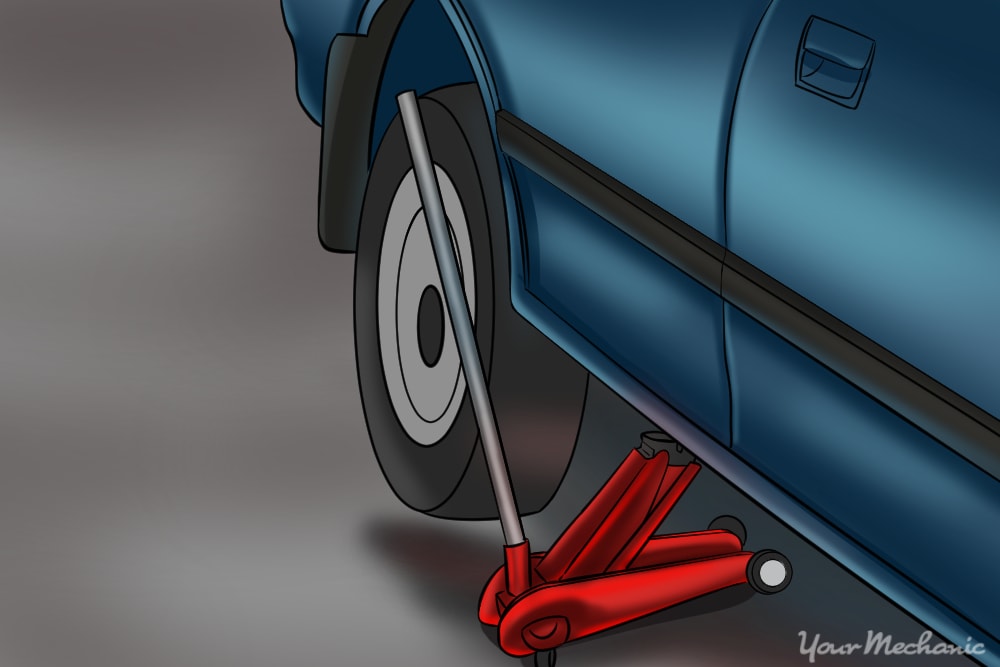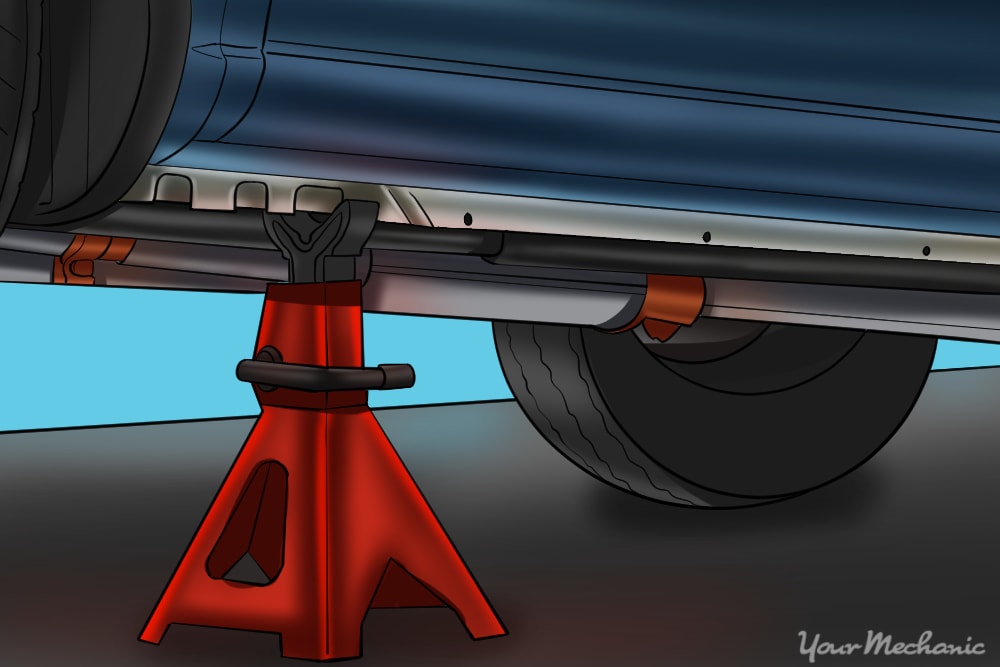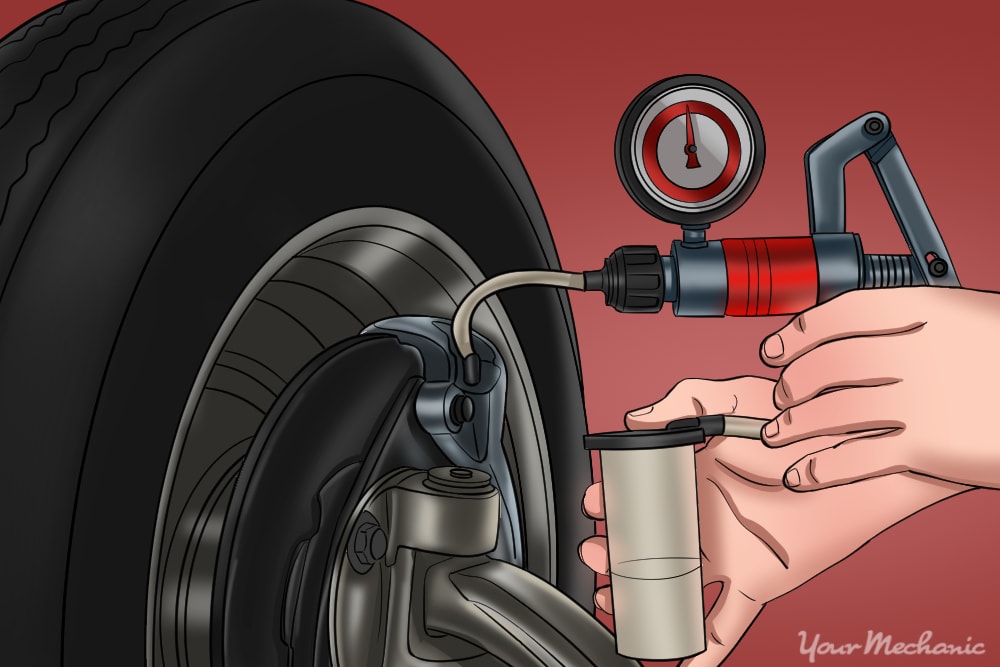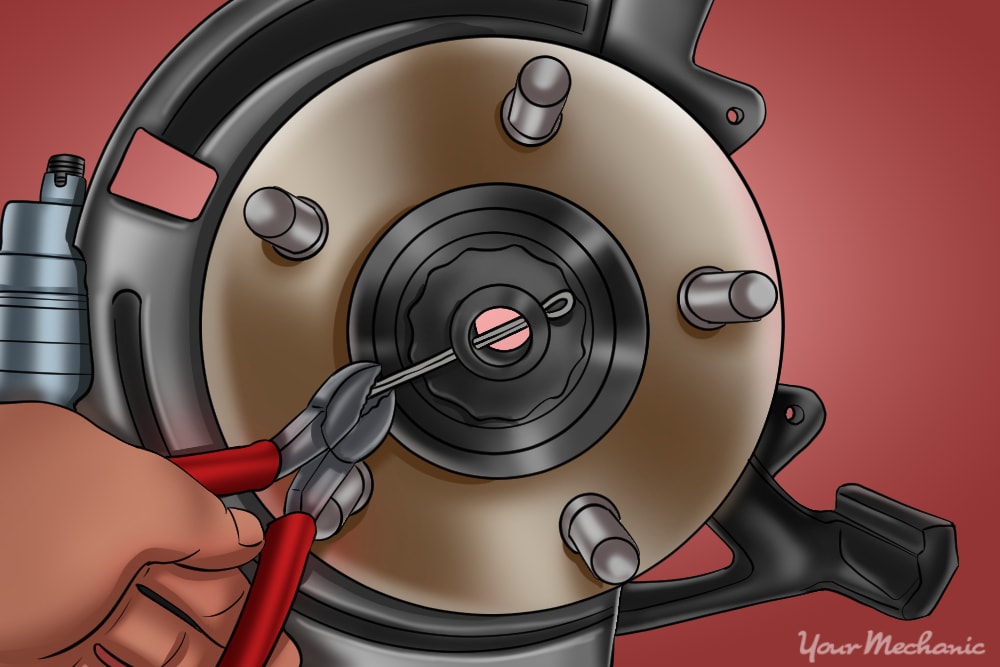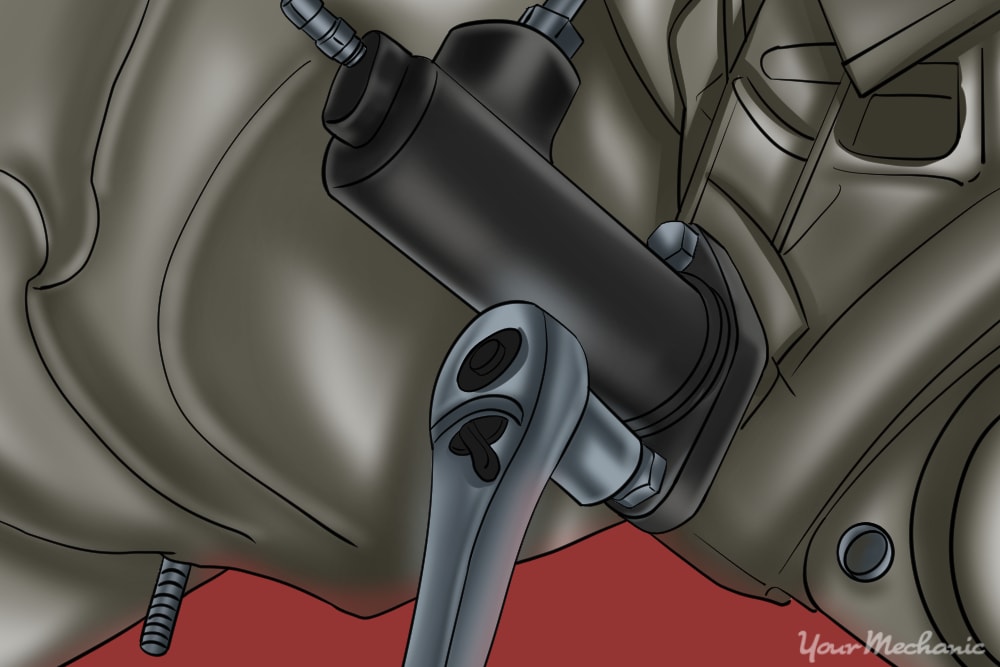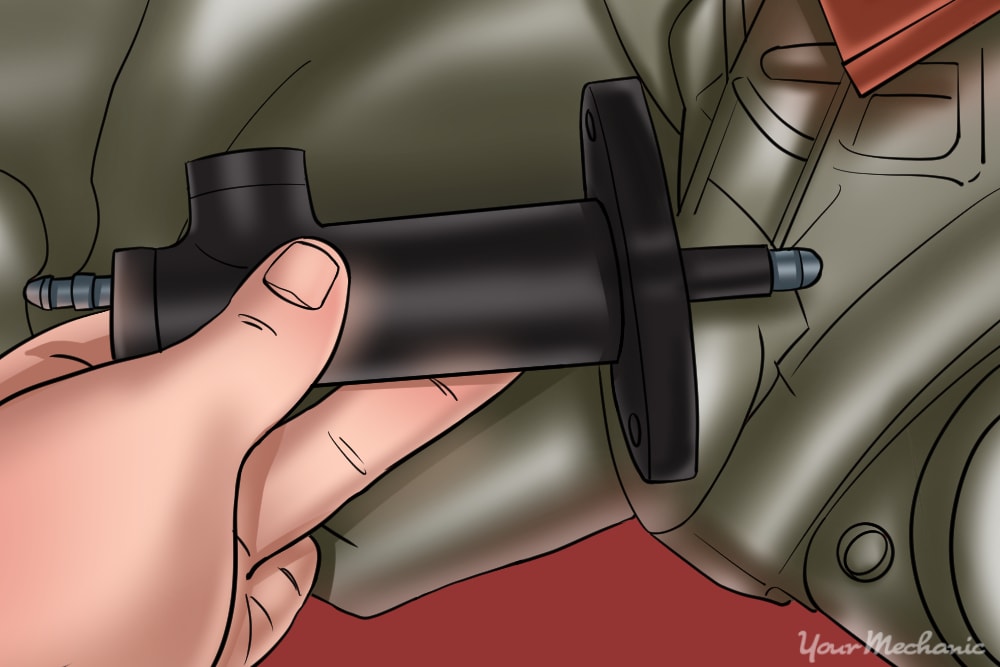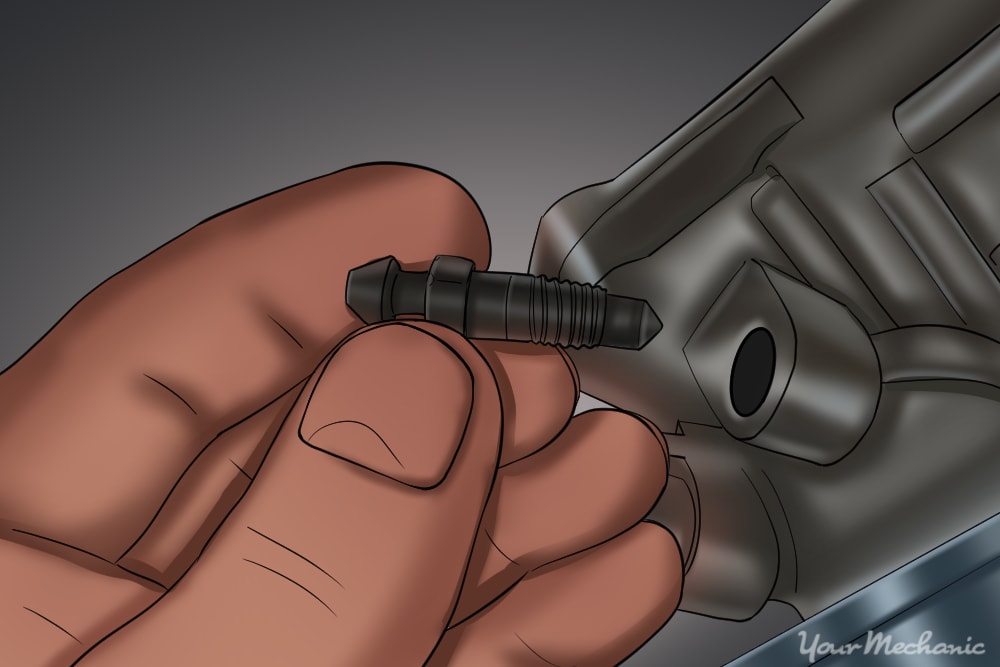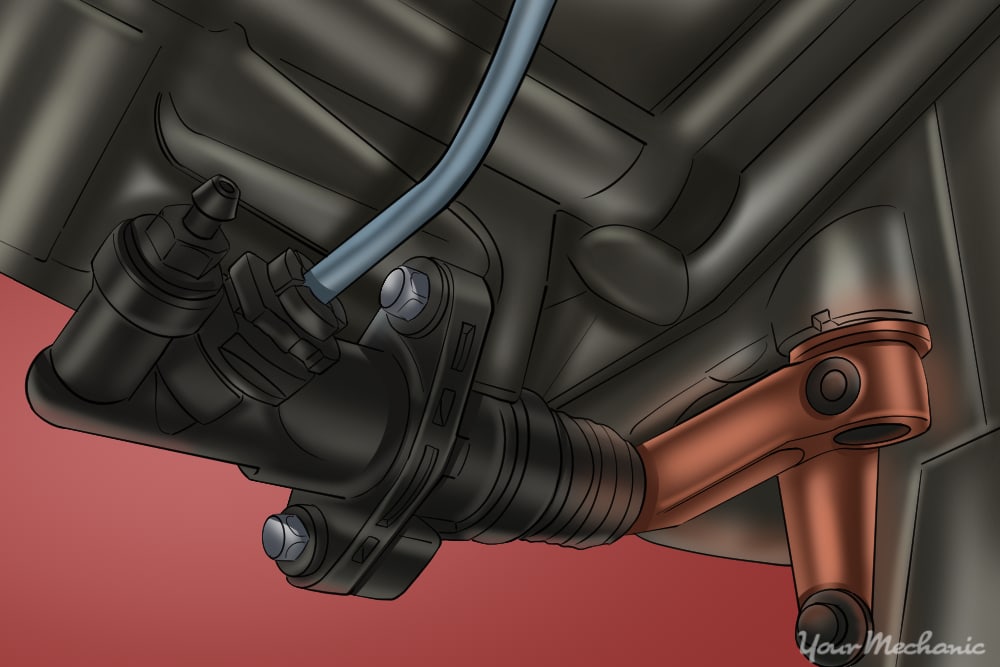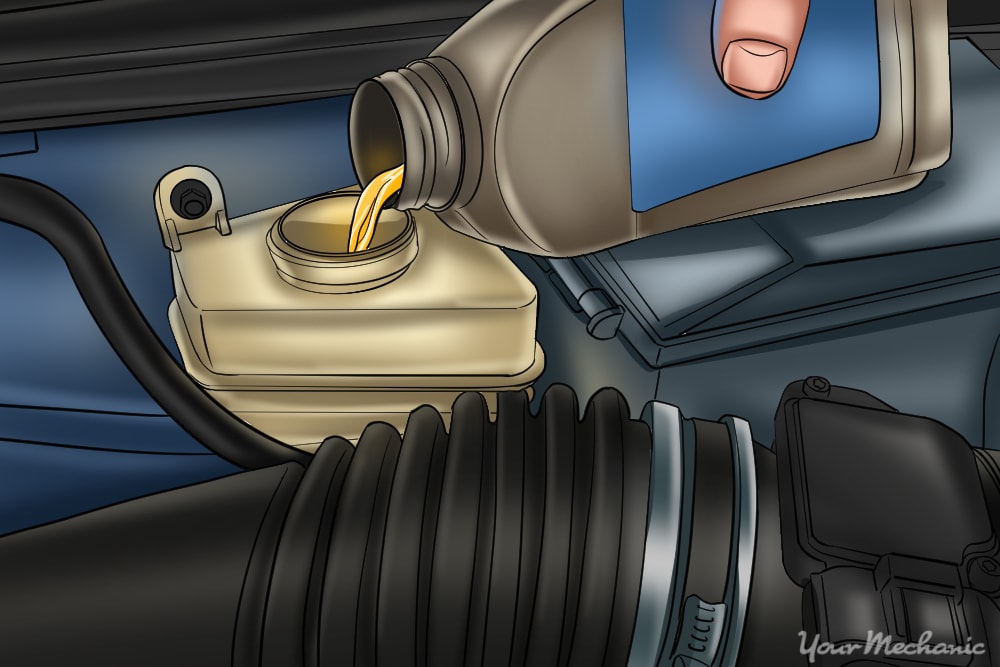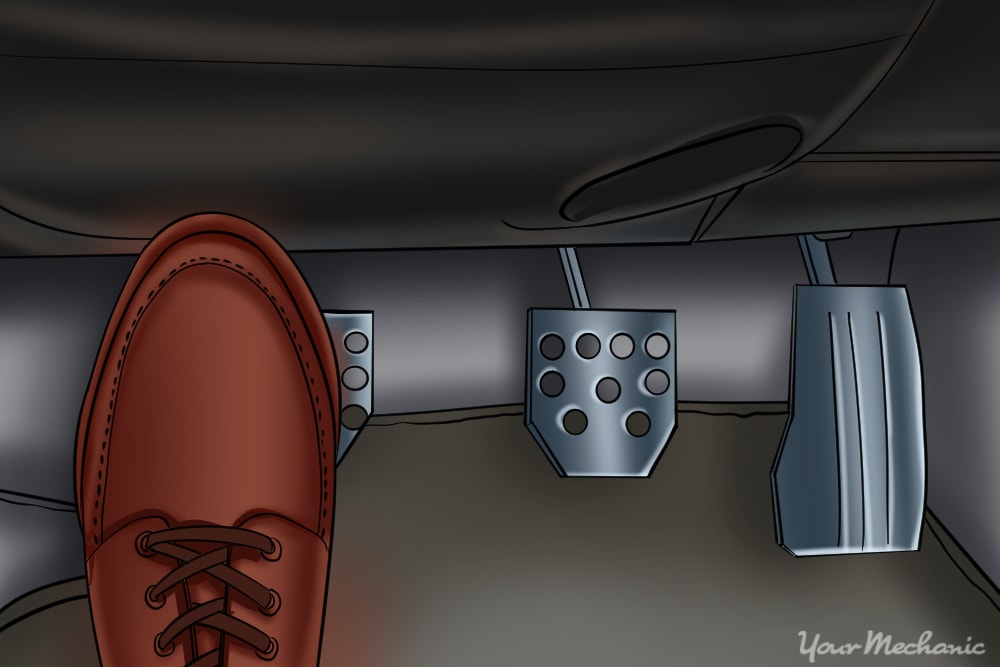

A clutch slave cylinder is a member of the clutch system that provides leverage assistance to the clutch fork. The clutch slave cylinder operates just like a hydraulic cylinder on a boom lift. The cylinder is connected to the clutch master cylinder located on the firewall next to the brake master cylinder through a hose.
When you push the clutch pedal, brake fluid flows from the clutch master cylinder to the slave cylinder, applying the pressure necessary to engage the clutch. When you release the clutch pedal, a return spring located on or in the slave cylinder will force the brake fluid back to the clutch master cylinder.
Part 1 of 8: Know the signs of failure
There are two different ways to determine if the clutch master cylinder is failing or has failed. The main chamber seal in the middle of the clutch slave cylinder will split and leak out brake fluid causing the reservoir in the clutch master cylinder to become low.
As the pedal is pushed down, the plunger inside the cylinder housing will cause brake fluid to spray out at a strong force past the seal. As the brake pedal is released, the spring tension from the return spring will pull the plunger back into its housing causing air it be drawn into the slave cylinder.
The return spring breaks or weakens then the slave cylinder push rod will remain pressed out with full force to the clutch fork. The clutch pedal will press down to the floor, however, it will not return when letting up on the clutch pedal.
Pascal’s law states that all areas that have confined fluid in them are not compressible and all pressure is equal in every location. The application of a larger dimension will have more leverage than a smaller dimension.
The Pascal’s law plays a large role in the clutch hydraulic system. As long as the system has fluid at the proper level, applied force, and all of the air bleed out, then the clutch hydraulic system will work correctly. However, when air is induced into the system the air becomes compressible allowing the fluid to create a stand still.
If the fluid is low or if the applied force is minimal, then the force will be low causing the slave cylinder to operate at about half way. This will cause the clutch to slip and not engage any gears as the clutch will not release properly.
Part 2 of 8: Preparing to work on replacing the clutch master cylinder
Materials Needed
- Flash light
- Floor jack
- Jack stands
Step 1: Park your vehicle on a flat, hard surface. Make sure that the transmission is in park (for automatics) or in 1st gear (for manuals).
- Note: This is only for vehicles with all wheel drive transmissions or rear wheel drive transmissions.
Step 2: Place wheel chocks around the rear tires. Engage the parking brake to the lock the rear tires from moving.
Step 3: Raise the vehicle. Using a floor jack, lift under the vehicle at its specified jacking points until the wheels are completely off the ground.
Step 4: Place the jack stands. The jack stands should go under the jacking point Locations then lower the vehicle onto the jack stands.
For most modern cars, the jacking points for jack stands will be on the pinch weld just under the doors along the bottom of the car.
- Note: It is best to follow the vehicles owners manual for proper jacking locations.
Part 3 of 8: Verifying the clutch slave cylinder condition
Material Needed
- Flashlight
Step 1: Grab your creeper and go under the vehicle. While using your flashlight, look at the clutch slave cylinder for any damage and leakage.
If you do not see any fluid leaking out pull back on the dust boot. Be sure to place a drip pan under the slave cylinder for that brake fluid may leak out.
Step 2: Open the hood to your vehicle. Locate the clutch master cylinder and remove the cover to the reservoir.
Verify if there is any brake fluid inside the reservoir.
Part 4 of 8: Removing the clutch slave cylinder
Materials Needed
- Allen wrench set
- Boxed end wrenches
- Brass punch
- Breaker bar
- Drip pan
- Fastener remover
- Needle nose plyers
- Ratchet with metric and standard sockets
- Torque wrench
- Torques bit set
- Vampire pump and bottle
Step 1: Grab your vampire pump with a bottle. Remove the reservoir cap from the clutch master cylinder’s reservoir.
Use the vampire pump and retrieve all of the brake fluid from the reservoir. When done removing all brake fluid, put the reservoir cap back on.
- Warning: Do not get brake fluid on any paint. This will cause the paint to peel and chip away.
Step 2: Grab your tools and go under your vehicle. Remove the hydraulic line from the clutch slave cylinder.
Be sure to put a plastic bag on the end of the line with the rubber band to keep brake fluid from leaking out of the line.
- Note: Do not bend the hydraulic line for it may crack or break.
Step 3: Remove bolts. Remove the two bolts or clamp that secures the slave cylinder to the transmission.
Part 4 of 8: Removing the clutch hydraulic system assembly
Materials Needed
- Allen wrench set
- Boxed end wrenches
- Brass punch
- Breaker bar
- Drip pan
- Fastener remove
- Needle nose plyers
- Ratchet with metric and standard sockets
- Torque wrench
- Torques bit set
- Vampire pump and bottle
Step 1: Grab your vampire pump with a bottle. Remove the reservoir cap from the cylinder’s reservoir.
Use the vampire pump and retrieve all of the brake fluid from the reservoir. When done removing all brake fluid, put the reservoir cap back on.
- Warning: Do not get brake fluid on any paint. This will cause the paint to peel and chip away.
Step 2: Remove the cotter pin. Go in the driver’s compartment of the vehicle and remove the cotter pin from the anchor pin on the clevis.
This will be attached to the clutch master cylinder push rod with a pair of needle nose plyers.
Step 3: Remove the anchor pin. Remove this from the clevis of the push rod.
Step 4: Remove the mounting nuts. Remove them from the clutch master cylinder.
Step 5: Locate the hydraulic line. It will link the clutch master cylinder to the slave cylinder.
Remove all mounting insulated clamps that mount the hydraulic line to the vehicle.
Step 6: Grab your creeper and go under the vehicle. Remove the two bolts or clamp that secures the slave cylinder to the transmission.
Step 7: Remove the entire system. Very carefully, remove the entire system (clutch master cylinder, hydraulic line, and slave cylinder) up through the engine compartment.
- Warning: Do not bend the hydraulic line for it will break.
Part 5 of 8: Prepare the slave cylinder and hydraulic system assembly
Materials Needed
- Allen wrench set
- Boxed end wrenches
- Brass punch
- Breaker bar
- Drip pan
- Fastener remove
- Needle nose plyers
- Ratchet with metric and standard sockets
- Torque wrench
- Torques bit set
- Vampire pump and bottle
Step 1: Prepare the clutch slave cylinder. Remove the clutch slave cylinder from its package.
Visually check to see if there are any damages to the cylinder and boot. You may have to install the return spring, push rod, and boot.
Step 2: Prepare the clutch hydraulic system assembly. Remove the clutch master cylinder and slave cylinder assembly from its package.
Visually check to see if there are any damages to the cylinder. Make sure that the seal is in the back of the clutch master cylinder housing.
Step 3: Take the clutch master cylinder and put it into a vise. Clamp down until the cylinder will not move.
Place the slave cylinder on a stool or something to support it.
Step 4: Remove the bleeder screw. Place a drip pan underneath the slave cylinder and remove the bleeder screw.
Step 5: Fill the reservoir up with brake fluid. Leave 1/4 inch from the top empty.
Step 6: Use the brass punch as an extension to prime the cylinder. Slowly pump the cylinder from the back of the clutch master cylinder.
Watch for the brake fluid to drip out of the slave cylinder. You will have to fill the reservoir about three times to fill the entire system. This primes the cylinder and removes most of the air inside the cylinder, hydraulic line, and slave cylinder.
When there is a solid stream of brake fluid coming out of the bleeder hole on the slave cylinder, stop and install the bleeder screw.
Step 7: Get a helper. Have the helper use the brass punch and pump the cylinder.
You then would need to loosen the bleeder screw to allow air to escape as brake fluid runs out.
- Note: You may need to loosen the bleeder screw up a few times during pumping cycles to remove all air in the hydraulic system.
Step 8: Make sure that the bleeder screw is tight. Fill up the reservoir with brake fluid to the fill line and install the reservoir cap.
Part 6 of 8: Installing the new clutch slave cylinder
Materials Needed
- Allen wrench set
- Boxed end wrenches
- Brass punch
- Breaker bar
- Drip pan
- Fastener remover
- Needle nose plyers
- Ratchet with metric and standard sockets
- Torque wrench
- Torques bit set
- Vampire pump and bottle
- Wheel chocks
Step 1: Grab your creeper and go under the vehicle. Install the clutch slave cylinder to the transmission mount.
Finger tighten the bolts and then tighten them at 1/8 turn. If the slave cylinder had a clamp, install the clamp and insure it is tight.
Step 2: Get your drip pan and place it under the slave cylinder. Remove the plastic bag from the clutch hydraulic line.
Install the clutch hydraulic line onto the slave cylinder.
- Warning: Do not cross thread the hydraulic line as you install it. Brake fluid will leak out.
Step 3: Bleed the hydraulic line to slave cylinder. Have a helper press the clutch pedal and hold it.
Loosen the bleeder screw up and let the air out of the system. Tighten the bleeder screw and have the helper release the clutch pedal.
You may need to perform the bleeding procedure a couple more time to remove all air. Tighten up the bleeder screw tight.
- Note: If the air does not all come out you will need to bleed the air from the line attached to the clutch master cylinder. Follow the same procedures as you did with the slave cylinder bleeder screw.
Step 4: Top off brake fluid. Remove the reservoir cap and top brake fluid off to the full line.
Part 7 of 8: Installing the clutch hydraulic system assembly
Step 1: Install entire system. Very carefully, install the entire system (clutch master cylinder, hydraulic line, and slave cylinder) down through the engine compartment.
- Warning: Do not bend the hydraulic line as it will break.
Step 2: Install the slave cylinder. Go underneath the vehicle and install the slave cylinder by screwing in the bolts finger tight plus 1/8 turn or by installing the clamp.
Step 3: Install the clutch master cylinder into the firewall.
Step 4: Install mounting nuts. Go in the driver’s compartment of the vehicle and install the mounting nuts onto the clutch master cylinder.
Torque them down to the specifications that will be given in the package. If there is no instructions, then tighten the bolts by hand plus 1/8 turn.
Step 5: Install the anchor pin into the clevis of the push rod.
Step 6: Install a new cotter pin. Install it in the anchor pin on the clevis attached to the clutch master cylinder push rod with a pair of needle nose plyers.
- Warning: Do not use the old cotter pin due to work harden and fatigue. The old cotter pin could break prematurely.
Step 7: Install mounting insulated clamps. Go back to the engine compartment and install all mounting insulated clamps that mount the hydraulic line to the vehicle.
- Note: Keep in mind, the clutch hydraulic system assembly is already primed and full of fluid with all of the air out of the system.
Step 8: Raise the vehicle. Using a floor jack, lift under the vehicle at its specified jacking points until the wheels are completely off the ground.
Step 9: Remove the jack stands. Keep them far away from the vehicle.
Step 10: Lower the vehicle to where all four wheels are on the ground. Pull out the jack and put it aside.
Step 11: Remove the wheel chocks from the rear wheels. Put them aside.
Part 8 of 8: Testing the new clutch slave cylinder
Step 1: Make sure that the transmission is in neutral. Turn on the ignition key and start the engine.
Step 2: Press down on the clutch pedal. Move the gear shifter to a selection of your choice.
The shifter should slide easily into the gear selected. Shut the engine off when you are done with the test.
Step 3: Drive the vehicle around the block. During the test drive change gears from first gear to the top gear one at a time.
Step 4: Press the clutch pedal down. Do this when moving from the selected gear to neutral.
Step 5: Press the clutch pedal down again. Do this when moving from the neutral position to another gear selection.
This is process is called double clutching. This insures that the transmission has little to no power from the engine with the clutch disengaged properly. The process is to prevent clutch damage and transmission gear damage. If you do not hear any grinding and the shifting feels smooth from one gear to another, then the clutch master cylinder has been fixed correctly.
If you cannot engage the transmission into any gear without grinding or if the clutch pedal will not move, then there may be further diagnosis of the clutch pedal assembly or a possible transmission failure. If the problem persists, then you should seek out help from one of our certified mechanic that can inspect the clutch and transmission and diagnosis the problem.



